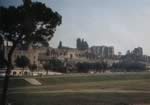

Panem et circenses!" "Bread and circuses!" chanted the mob of plebeians in front of the Roman Forum. From 753 B.C. to 476, it was, just as today, in a politician's interest to meet the people's demands.
To curry favor with constituents, emperors addressed the basics--a monthly handout of free grain calles the Annona--as well as the extravagant--grandiose spectacles staged without admission charge in the Circus Maximus, the oldest and largest stadium constructed for the sole purpose of entertaining the public. At its pinnacle in the fourth century, the venue's seating capacity (yet to be surpassed) was 350,000 spectators.
Chariot races had been contested on the site of the Circus Maximus since the time if Romulus (753 B.C.), but it wasn't until 329 B.C. that a permanent structure was erected. In the first century B.C., the Circus Maximus held 100,000 fans, but by the fourth century, the popularity of the games necessitated expanding the seating capacity to more then 350,000. The elongated U-shaped structure measured approximately 2,035 feet by 460 feet, longer then six modern football fields and more then three times as wide
On race day men, women and children began to pour into the Circus (a word coined by the Romans) before dawn. It was so crowded late-comers were obliged to hire someone to save their seats. And there was a dress code--no man was admitted unless attired in a toga, the badge of citizenship.
Blaring trumpets heralded the entry of the presiding consul in his chariot, attended by his imposing retinue, followed by horses, chariots and drivers.
Bets were placed, and at the signal chariots charged from12 gates to negotiate seven laps (approximately five miles). The sight of tangled bodies, screaming horses, broken limbs, wheels rolling aimlessly, brought cheers from the raucous crowd.
Like contemporary athletes, the best charioteers were lionized by the public and were fabulously wealthy. In the second century, the Roman satirist Juvenal observed that "a chariot driver could earn 100 times the fee of a lawyer!"
More then 100 days a year were public holidays in ancient Rome, and no celebration was complete without a day at the Circus Maximus.
Near the turn of the third century, the Christian writer Tertullian condemned the excesses of these events decrying the games for leading to a "general decay of manners" and calling the circus the "devil's playground {where} madness rules."
Wild beasts, and even human captives, were exhibited in the Roman circus, often cruelly. It was in the Circus Maximus, and not the Colosseum, where Nero pitted the Christians against the lions.
The last recorded chariot race was in 549; for more than 1,000 years horses raced at the Circus Maximus, but with the fall of the Roman Empire the circus became a thing of the past. The tradition, however, endured in the Westen world's wandering troops of performers and clowns.
Today, more then 2,000 years after charioteers exercised their sporting franchise, jogger's exercises around the ancient circuit, and an occasional Frisbee flies above.
Search the Web for related information on the Circus Maximus
Home | North
America | South & Central America | Europe
Asia & Middle East | Africa
| Oceania | Favorite
Accommodations
Travel Images Blog
| Preferred
Accommodations Blog
Travel Blog | Columns
| About Sandra | Contact
Sandra | Site Map
Copyright
© 2002-2007 Sandra Scott. ALL RIGHTS RESERVED
Site
designed and created by C.F. Howley
